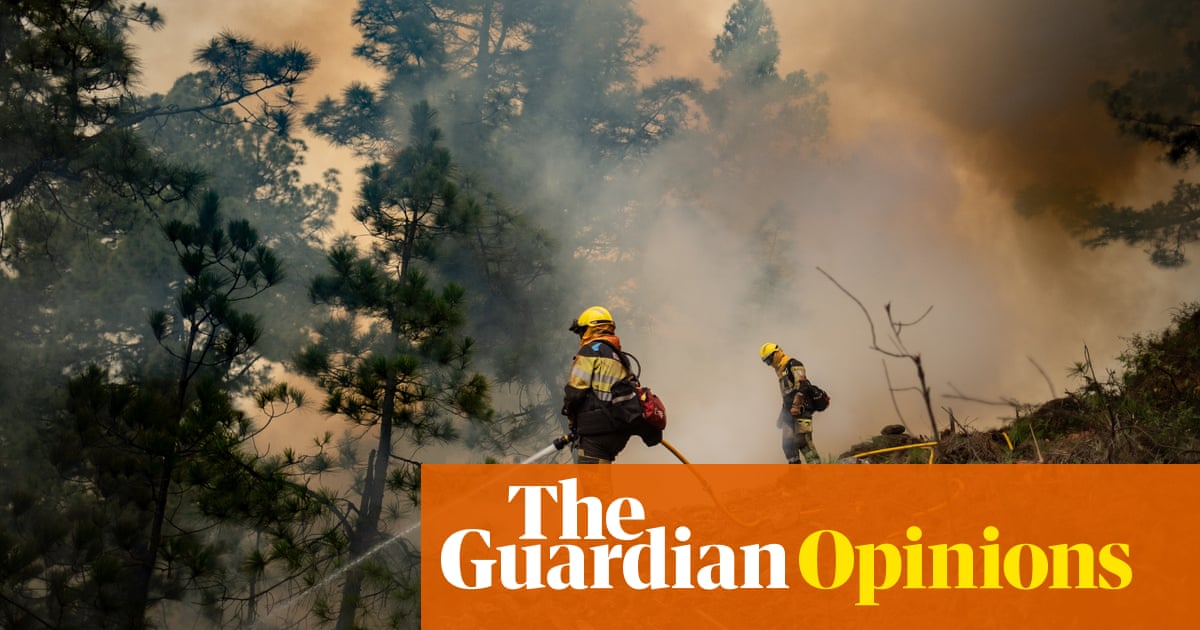
Land temperatures have hit 60Cin Spain, satellite data shows, with tourists warned to stay off beaches throughout the Mediterranean. Across the pond, more than 100 million Americans are still under extreme heat warnings. The “heat dome” squatting over the south sent thermometers soaring to 56C in Death Valley yesterday, close to the hottest ever recorded on Earth.
The sea is little cooler, with Florida ocean temperatures well above 30C. Further north on land, people are being rescued by dinghies and helicopters from suburban streets as heavy rain causes flooding across Pennsylvania and New York and into New England. Vermont has declared a state of emergency. The National Weather Service has issued a tornado watch for parts of the midwest, and a severe thunderstorm watch for other states. Parts of Canada have been on fire for months.
Conditions are similarly apocalyptic elsewhere. Cars swirl like bath toys down flooded streets in Japan and India. China has been cooking for weeks in temperatures in the 40Cs, with power outages as grids struggle to cope. In Europe, the world’s fastest-warming continent, temperatures of 48C are expected. Last year, over 60,000 died here from heat; this year will be hotter. Normal has gone: this is our new world.
Where are you at with your five stages of grief for the Holocene? That’s the geological epoch we were living in for the past 11,700 years – the period of time when humans invented agriculture, built cities, invented writing, became “modern”, essentially. All of history took place in this epoch, marked by its congenial, relatively predictable climate, in which ice sheets retreated from Europe and North America, and atmospheric carbon dioxide levels were high enough to enable the flourishing of grains, like rice and wheat.
Now we’ve left those Holocene conditions for the uncharted Anthropocene, an age brought about by human activities and characterised by global climate chaos and ecological degradation. Last week, members of the Anthropocene Working Group (AWG) of scientists selected Crawford Lake in Canada as the best site to mark the epoch’s geological start. If their bid is successful, the International Union of Geological Sciences could officially – momentously – declare the Anthropocene in August 2024.
Everyone thinks their own time is significant, but we truly are living in exceptional times. Most geological episodes span millions of years, making the Holocene a relative blink at the end of the Pleistocene’s 2.5m. As for how long the Anthropocene will last … Well, that depends how long humans persist for (and whether what succeeds us has any interest in paleobiology).
Our Earth-dominating predecessors, the dinosaurs, didn’t have the time – or brains – to grieve a passing epoch. Their world crossed instantly from one geological boundary to another, courtesy of a massive asteroid impact that extinguished three-quarters of all animal and plant species. That geological boundary, from the Cretaceous to the Palaeogene, is marked by a thin stripe in layers of rock that contains a spike in levels of iridium. The heavy metal was deposited into sediments globally by the asteroid 66m years ago.
Our own period of dominance will also show up in the future fossil record. The stamp is on everything from the accumulation of plastics and concrete to an explosion of manipulated life forms, like domesticated chickens and corn seeds. We’ve changed the planet’s landscapes, river flows, the chemistry of the air and oceans, created cities and reservoirs, and reconfigured nature. Today, just 4% of the world’s mammals are wild; the rest we have modified to feed or serve us.
The AWG chose the radioactive metal plutonium as a marker for our Holocene-Anthropocene boundary. Plutonium pollution spiked globally during the nuclear weapons tests of the 1950s until the international test ban treaty in 1963. Undisturbed sediments in the protected Crawford Lake offer a particularly good record of that. The plutonium blip coincides with “the great acceleration”, a surge in all human activity. That activity, said Colin Waters, the group’s chair, is “no longer just influencing Earth’s sphere, it’s actually controlling” it.
If humanity really is at the controls, then it is drunk. We’re careering into the Anthropocene with scant regard for natural ecosystems or climate tipping points – or our own safety.
This June was the hottest ever recorded on Earth. July led with the hottest ever day, swiftly followed by a hotter hottest ever day, then the hottest week – and, possibly, the hottest month. A few years hence, during the ceaseless climate catastrophes of the 2030s, as my kids’ generation reaches adulthood, they might ask about that terrifying summer of 2023 when 120,000-year-old heat records were smashed day after day: how did everyone react?
Will labelling this Anthropocene epoch help to move us from denial, the first stage of grief, through to acceptance? I find myself experiencing all stages simultaneously. Anger that my children won’t get to snorkel the wondrous coral reefs of my Australian childhood; pain and guilt over the millions of Indian villagers displaced by floodwaters, losing their homes, livelihoods, even their lives. Depression over the scale of loss: of wildlife, of glaciers, of verdant landscapes, of safe, reliable weather.
It is the last two stages we need to reach – acceptance and reconstruction – if we are to build a livable Anthropocene. We need to take the controls with purpose, focused on this goal.
We have among us humans who, like President Biden, are able to appreciate the gravity of spanning different geological epochs, and children who are cursed or blessed with the Anthropocene we are making. Allow yourself a moment to grieve, then take your place in the workshop of this extraordinary time: we have a better age to create.
Gaia Vince is the author of Nomad Century: How to Survive the Climate Upheaval












